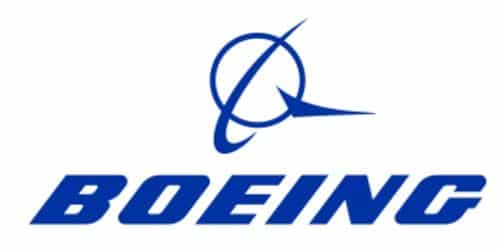The Boeing Company was one of the first companies to start making planes and satellites. It is also the largest plane and satellite maker in the world. For a long time, it was known simply as the Boeing Airplane Company, which misrepresented the breadth of its operations. The company changed its name so it could focus on more than just making planes. It now makes missiles, military planes, and planes for commercial use. The Boeing logo is one of the most recognizable in the world. The blue logo is both simple and elegant; it blends a logotype with stratotype typography. This piece focuses on everything about Boeing, including its history, old logo, font, colors, stock, as well as various Boeing careers.
What does the Boeing logo mean?
The Boeing logo is one that represents development, progress, and vigor. The logo depicts cutting-edge innovations, and the development of things that can be shot into space and across the world. Additionally, it conveys aspiration to the vastness of spacetime.
The fact that the name of the company’s founder is still included in the emblem says a lot about the company. It is a testament to its legitimacy. According to the company’s website, the Boeing logo nevertheless “remains an iconic emblem of what one can achieve if one dares to dream.”
Boeing Logo History
The Boeing Corporation, usually known as Boeing, is a well-known multinational aerospace and military company headquartered in the United States. Boeing is a global leader in the aerospace industry, basically producing commercial jets and military aircraft. It was established in 1916 in Seattle, Washington by an American businessman named William E. Boeing.
In the 1920s, the Boeing business created its first logo, which featured three separate insignia. The first was basically an illustration of the bird in flight to the east, with an arrow pointing upwards to the spot where the wordmark represented forward motion and individuality.
The second badge has a stylized pair of wings with a vertical bend and a pair of loops at the center. It looked like the emblem of a high-end automobile, a guarantee of superior craftsmanship and style. The third Boeing logo on the other hand had a white wordmark with a black outline that was strewn with white wings. The Boeing logo was sleek and modern, perfectly representing the company’s values and reputation.
The concept of 1939 gave the aircraft manufacturer a new look and shape on the outside. By elongating the letter “G,” a pedestal with two wings is formed around a vertically positioned word label, creating a talisman. A stunning and memorable logo, it generally became instantly recognizable and served the group well for the next decade.
An entirely new concept of brand style was introduced in 1940. The logotype was designed using a script font and set at an angle, with the star taking the place of the dot over the “I.” An enormous and often graceful emblem of fashion’s forward momentum and high quality, it stood for innovation and change in the industry.
Bob Laly and Kith Kinsmen Designs
Kith Kinsmen and Bob Laly, are basically the two designers of Boeing. They set out to make a logo for Boeing’s business. A logo that would stand the test of time in 1947. Hence, they unveiled a 10-page logo proposal with various concepts for the mark’s look, reflective qualities, and textured backgrounds. A new design with just the word “Boeing” replaced the totem-based emblem in that same year. In order to create this logo, they used the stratotype typeface. The design was used in tandem with aircraft model numbers over the next decades until the 1990s. It is during this time that it underwent a number of redesigns and updates.
After Boeing and McDonnell Douglas Corporation merged in 1997, the company’s logo was also updated to reflect the combined businesses’ histories. The powerful logotype uses a visually appealing and instantly recognizable symbol: a ring containing a stylized wing. The new logo was unveiled in a blue and gray color scheme, with the blue being used for the lettering and the grey being used for the icon; this color scheme perfectly encapsulates the organization’s goals and objectives, as blue is associated with the sky and air, while gray is associated with speed and security. In the Boeing logo, domination, power, and success are all symbolized by the use of blue color in the Boeing logo.
Present Boeing Corporate Logo and Font
American graphic designer Rick Eiber created the brand-new logo. In addition to the Boeing name in the new Stratotype font, the sphere is now an integral part of the logo. The blue glow of the illuminated lettering is meant to represent the sky. The very design of the logo, on the other hand, conveys the group’s aspiration for growth, prosperity, and a bright future.
The traditional logo is presented in an altered sans-serif style, likely derived from the Tipemite Oblique or House Sans Italic Heavy typefaces, with all characters capitalized. The inscription is whole and, ideally, well-balanced; it conveys bravery and independence and also inspires confidence, calm, and trust.
Boeing Logo Font and Colors
The McDonnell Douglas-inspired logo was generally designated as the official mark of the defunct Douglas Aircraft. At one time, the triangle stood for a military plane, the circle signified Earth, and the arc line resembled a missile track. Rick Eiber maintained the logo’s core concept while giving it a more abstract visual representation. As the aerospace sector continues to grow and expand, the emblem also represents this ascent to new heights.
According to what is currently known, the font used for the Boeing logo is referred to as Stratotype. It was generally designed by two different individuals: Bob Laly and Kith Kinsmen. k. It’s a bold, oblique grotesque that you would also recognize from airline seat numbers. The logo of geometric shapes and the writing are both blacks in color.
What Does 7 Mean in Boeing?
Accordingly, the number 707 was designated for the very first commercial passenger airline in the series (pronounced Seven Oh Seven). The Boeing 707 is generally regarded as the aircraft that marked the beginning of the “Jet Age.” It was agreed that all model numbers that started with a “7” or concluded with a “7” would be reserved for use on commercial aircraft.
Who Designed the Boeing Logo?
In 1947, Kith Kinsmen and Bob Laly, who are basically the two designers of Boeing, set out to design a logo for Boeing’s business. They plan to design a permanent logo that will stand the test of time. Hence, they unveiled a 10-page logo proposal with various concepts for the mark’s look, reflective qualities, and textured backgrounds. A new design with just the word “Boeing” replaced the totem-based emblem in that same year. However, in order to create this logo and make it a success, they used the stratotype typeface. The design was used in tandem with aircraft model numbers over the next decades until the 1990s. It was during this time that it underwent a number of redesigns and updates.
Why Do Boeing Planes Start with 7?
The jet-powered aircraft were generally given the designation of number 700 by the engineering division. However, the marketing staff at Boeing decided to interfere, and just like 007 sounds better than 7, so does 707. Boeing found the number 7 to be so enticing that it has used it as the starting and stopping point for every jet aircraft type it has ever produced.
Since then, Boeing has consistently improved their planes, beginning with the 727 in the 1960s and ending with the 787 Dreamliner in the 2010s. However, the company did take a step back with the narrow-bodied, short-range 717, which didn’t enter commercial service until 1999, long after Boeing’s 777.
Why Does the 737 Not Have a Rat?
Since it is unnecessary, the Boeing 737 does not come equipped with a Ram Air Turbine (RAT). When both of the primary engines fail, the hydraulic pressure is provided by the windmilling engines’ Engine Driven Pumps (EDPs), which are backed up by the electrical motor-driven pumps (EMDP). It is possible that the EMDP might still function using power from the APU or the batteries in the event of a simultaneous failure of both engines.
The 737 has manual reversal on the flying controls, so it can be flown even if all hydraulics fail. Extremely strong stick forces, but the plane is still manageable.
Why is There No Row 13 on Planes?
The number 13 is considered unlucky in many different cultures. Hence, several airlines have chosen to eliminate the number from their seating arrangements so as not to incite the superstitions of their consumers. This is because many airlines would rather not risk offending their clients.
There is an awareness of these superstitions among airlines all over the world. Thus, several of these airlines do not have a 13th row on their aircraft. The irrational fear of the number 13 is called triscaidekaphobia (sometimes spelled triskaidekaphobia).
Why Boeing 747 Have a Hump in the Front?
Because of the need to improve the plane’s aerodynamic efficiency, Boeing moved the cockpit up over the nose cone, creating a distinctive “hump” on the plane’s side. There would be greater capacity for first-class passengers on the upper deck thanks to the hump being moved further back in later 747 models.
Even though Juan Trippe was first skeptical, the 747 went on to become a smashing success, with over 1,500 being manufactured in the last 50 years alone. You can still find a hybrid 747 in service today, as several airlines fly both passenger and cargo variants of the plane. In place of removing the nose cone, KLM has transformed the plane’s rear into a second cargo hold for its fleet of 747 Combis. Instead of KLM’s standard capacity of 408 passengers, this plane can hold up to 268.
Why Do Airbus Pilots Say Blue?
The callouts from the pilots, such as “LOC blue,” serve two purposes: they serve to remind the pilots of the current flight guiding modes, and they serve to keep the pilots informed of any changes to the mode. This is done to guarantee that their mental image of “what the aircraft will do next” is current and accurate, as well as that it corresponds to the circumstances of the current flight.
What Does 777 Mean in Boeing?
The Boeing 777 is a twin-engine, wide-body airplane that can travel great distances. The plane is the largest twin jet in the world. The “Triple Seven” is a common name for it. It has a passenger capacity of 283, with an upper limit of 368. Its range extends from 5235 nautical miles all the way up to 9380 nautical miles.
Carriers all over the world have had a lot of success with the Boeing 777, though, because it has a very long range, uses very little fuel, and has a lot of amenities that people like. And with the introduction of the 777-300ER, airlines have a fantastic new chance to build on their past successes. The 777 still has the best flight experience in the business, and recent updates have cut costs and brought in even more money.
Who is Boeing Owned By?
On July 15, 1916, William Boeing established Boeing in the city of Seattle, in the state of Washington. The merger that took place between Boeing and McDonnell Douglas on August 1, 1997, led to the formation of the current firm. Philip M. Condit, who had been chairman and CEO of Boeing, took on those roles in the merged business, while Harry Stonecipher, formerly the CEO of McDonnell Douglas, became the president and Coo of the combined corporation.
Boeing offers worldwide service and support, as well as order and delivery finance.
However, why William Boeing was the company’s founder, the leading shareholders of Boeing are as follows:
- Timothy J. Keating
- Leanne G. Caret
- Theodore Colbert
- Vanguard Group Inc.
- BlackRock Inc. (BLK)
- Newport Trust Co.
What Does Boeing Company Do?
Boeing is the world’s largest aerospace corporation, designing, building, and servicing aircraft for commercial airlines, the military, and the space industry. The corporation, a leading exporter in the United States, draws on the skills of its international supplier network to improve economic growth, environmental responsibility, and social impact. Boeing has a diversified team that is dedicated to the company’s core principles of safety, quality, and integrity, as well as to innovating for the future, leading with sustainability, and developing a culture based on these ideals.
When it comes to aerospace, Boeing has always been at the forefront of innovation and leadership. The organization is always developing new offerings to better serve its clientele. It is also able to design, manufacture, and integrate military platforms and defense systems. Likewise, it develops and implements cutting-edge technological solutions, offers flexible payment plans and other novel services to its clientele; and much more besides.
About 140,000 people work for Boeing in the United States and over 65 other countries. The company’s headquarters are near Washington, D.C. This is undeniably one of the most interesting and creative groups of people working today. It is, however, important to note that Boeing also benefits from the efforts of hundreds of thousands of competent people employed by Boeing’s suppliers around the world.
Boeing has three distinct divisions: Commercial Airplanes; Defense, Space & Security; and Boeing Global Services (which launched on July 1, 2017). Boeing Capital Corporation, a provider of financial solutions worldwide, is there to aid these divisions.
What is Boeing’s Biggest Plane?
The new Boeing 777X will be the largest and most fuel-efficient twin-engine jet in the world. The 777X will have 10% less fuel consumption, 10% fewer pollutants, and 10% lower operating expenses than its rivals thanks to advancements in aerodynamics and engines. The 777X is the newest member of the 777 families and provides low-risk, lucrative growth, unparalleled reliability, and seamless connection with the 777 and 787 Dreamliner families, allowing for even greater versatility. Nevertheless, output only scratches the surface. The 777X will usher in the future of air travel with its extra-wide and airy cabin, brand-new bespoke architecture, and features borrowed from the 787 Dreamliner.
What is Boeing Stand For?
The Boeing Company is an American aerospace and defense conglomerate that designs, builds, and markets aircraft, rotorcraft, rockets, satellites, telecommunications equipment, and missiles around the world. In addition to selling and supporting products, the company also offers leasing. Boeing is the largest U.S. exporter by dollar volume and ranks among the top aerospace manufacturers worldwide.
Likewise, Boeing is projected to be the third-largest defense contractor in the world by 2020. Boeing stock is currently included in the Dow Jones Industrial Average. The state of Delaware is the home of Boeing’s corporate headquarters.
Who is Bigger Boeing or Airbus?
The Airbus A380-800 has a maximum capacity of 853 passengers. It is generally the largest passenger aircraft in the world. The Boeing 747-400, which is the world’s second-largest passenger plane, has 193 fewer seats than this aircraft does.
Who is the Largest Airplane Manufacturer in the World?
Airbus Americas, with $78.9 billion in annual sales. It is basically the world’s largest airplane manufacturer. The aircraft manufacturing sector is expected to be worth $562.5 billion worldwide by 2022. In 2021, Airbus produced 611 airplanes by itself.
So, between now and 2030, the global market for making planes is expected to grow at a CAGR of 3.7%.
Airbus SE, founded in Europe in 1970, has been at the forefront of aerospace manufacturing for decades. Nonetheless, as of the year 2019 onward, Airbus has officially overcome Boeing and has remained in the number one position.
Airbus is a global company. Its headquarters are generally in the Netherlands, France, and Spain. They produce planes for both the military and the general public, and their planes have transported over 12 billion people throughout the world.
There is no denying the group’s track record of accomplishments, but it is also not without its share of controversy. Government subsidies for Airbus have been the subject of one of these debates due to questions about their legitimacy and fairness.
Stock Boeing
Boeing and its subsidiaries or affiliates design, develop, manufacture, sell, service, and support commercial jetliners, military airplanes, satellites, missile defense, human space flight, and launch systems, as well as support services around the world.
Boeing is basically organized into the Commercial Airplanes, Defense, Space & Security, Global Services, and Boeing Capital divisions.
Passenger and cargo commercial jets, as well as fleet support services, are all part of what the Commercial Airplanes division has to offer.
Research, development, production, and modification of manned and unmanned military aircraft and weapons systems; strategic defense and intelligence systems, including strategic missile and defense systems; command, control, communications, computers, intelligence, surveillance, and reconnaissance; cyber and information solutions; and intelligence systems; and satellite systems, including government as well as commercial Satcom, are under the defense, space, and security.
On the other hand, supply chain and logistics management, engineering, maintenance and modifications, upgrades and conversions, spare parts, pilot and maintenance training systems and services, technical and maintenance documents, data analytics and digital services, and so on are all products and services offered by the Global Services division to commercial and defense clients.
Financing services, meanwhile, are provided, and financing exposure is also managed, for a diversified portfolio of assets, including operational leases, sales-type/finance leases, notes, other receivables, assets held for sale or re-lease, and investments in the Boeing Capital segment.
Is Boeing Stock Currently a Buy, Sell, or Hold?
As of the time of this write-up, the stock of Boeing has been given a buy recommendation by the majority of analysts. A total of 34 buy ratings, 13 hold ratings, as well as 3 sell ratings, contributed to the calculation of the average rating score of Baa2.
What was the 52-Week Low for Boeing Stock?
As of the time of this writing, the price of Boeing shares has basically reached a low of 113.03 throughout the past 52 weeks. In general, based on the current price, Boeing is trading at a level that is 120.46 percent higher than its 52-week low.
What was the 52-Week High for Boeing Stock?
The share price of Boeing reached a 52-week high of 233.94 just over a year ago. According to the present pricing, Boeing is located 58.20 percentage points away from its all-time high during the past 52 weeks.
What are Analysts Anticipate for Boeing Stock?
The fifty analysts who generally make price predictions for Boeing have come up with a price goal of $234.02 as a group. This is basically a range that extends from a high of 306.00 to a low of 98.00. When compared to the most recent price, which was 136.16, the difference between the median estimate and that price is 58.18.
Boeing Historical Annual Stock Price Data
The table below shows Boings’ annual stock price data from 1994 till date;
| Year | Average Stock Price | Year Open | Year High | Year Low | Year Close | Annual % Change |
| 2022 | 164.9660 | 207.8600 | 225.9600 | 115.8600 | 137.3400 | -31.78% |
| 2021 | 224.5404 | 202.7200 | 269.1900 | 188.1900 | 201.3200 | -5.95% |
| 2020 | 196.8708 | 331.3339 | 345.3797 | 95.0100 | 214.0600 | -33.90% |
| 2019 | 358.8035 | 314.6652 | 430.3480 | 302.1198 | 323.8189 | 3.33% |
| 2018 | 331.8952 | 282.8312 | 379.4708 | 282.6692 | 313.3922 | 11.53% |
| 2017 | 202.9859 | 145.4635 | 283.8411 | 145.4635 | 280.9922 | 94.77% |
| 2016 | 121.5523 | 125.9330 | 146.2419 | 98.1074 | 144.2681 | 11.32% |
| 2015 | 127.1341 | 113.6072 | 139.2521 | 111.4916 | 129.5989 | 14.05% |
| 2014 | 110.9716 | 116.7333 | 123.3100 | 102.8529 | 113.6335 | -2.53% |
| 2013 | 87.4350 | 64.5373 | 118.1767 | 61.6734 | 116.5795 | 84.74% |
| 2012 | 60.6043 | 60.6770 | 63.8088 | 55.6197 | 63.1054 | 5.24% |
| 2011 | 56.2933 | 52.9630 | 64.1397 | 46.6404 | 59.9657 | 15.20% |
| 2010 | 52.1292 | 43.7123 | 59.2166 | 43.7123 | 52.0537 | 23.59% |
| 2009 | 34.5661 | 33.9084 | 43.6111 | 22.2213 | 42.1172 | 31.72% |
| 2008 | 49.0953 | 63.3795 | 64.3305 | 27.8086 | 31.9751 | -50.03% |
| 2007 | 68.7221 | 64.3005 | 77.9118 | 61.6035 | 63.9941 | -0.11% |
| 2006 | 57.2633 | 50.0418 | 65.6922 | 47.2428 | 64.0625 | 28.38% |
| 2005 | 43.9388 | 35.6224 | 50.7878 | 34.6929 | 49.8997 | 37.91% |
| 2004 | 33.0835 | 28.8738 | 38.6206 | 26.6994 | 36.1815 | 24.86% |
| 2003 | 22.6739 | 22.8163 | 29.0733 | 16.9701 | 28.9770 | 30.43% |
| 2002 | 26.4826 | 25.2003 | 33.7929 | 19.4114 | 22.2169 | -13.38% |
| 2001 | 33.9943 | 40.4520 | 45.1327 | 19.5863 | 25.6500 | -40.43% |
| 2000 | 31.4541 | 25.8976 | 45.6325 | 20.9399 | 43.0619 | 61.26% |
| 1999 | 26.1648 | 20.9405 | 30.4957 | 20.9405 | 26.7031 | 28.73% |
| 1998 | 27.3192 | 30.6821 | 35.2892 | 19.5644 | 20.7434 | -32.48% |
| 1997 | 32.9379 | 32.2597 | 37.4587 | 26.9101 | 30.7198 | -7.10% |
| 1996 | 27.1297 | 24.4872 | 33.1042 | 23.0248 | 33.0670 | 37.62% |
| 1995 | 18.4761 | 14.0862 | 24.0274 | 13.4082 | 24.0274 | 69.67% |
| 1994 | 13.5195 | 12.8508 | 14.8611 | 12.5179 | 14.1615 | 11.17% |
Boeing 30-Year Stock Price History
| Year | Average Stock Price | Year Open | Year High | Year Low | Year Close | Annual % Change |
| 1993 | 11.0571 | 11.3661 | 13.1453 | 9.7134 | 12.7389 | 10.68% |
| 1992 | 11.7452 | 13.2292 | 15.2255 | 9.6797 | 11.5095 | -13.91% |
| 1991 | 13.1103 | 12.3083 | 14.5907 | 11.5857 | 13.3692 | 7.42% |
| 1990 | 13.0289 | 10.9980 | 16.6935 | 10.2612 | 12.4454 | 17.20% |
| 1989 | 9.0415 | 6.9442 | 10.9980 | 6.8137 | 10.6189 | 50.40% |
| 1988 | 6.3313 | 4.3860 | 7.8132 | 4.3860 | 7.0606 | 68.60% |
| 1987 | 5.2837 | 5.8448 | 6.0836 | 3.8914 | 4.1879 | -26.95% |
| 1986 | 6.1939 | 5.8874 | 7.2465 | 5.1865 | 5.7326 | -2.16% |
| 1985 | 5.0072 | 4.0558 | 5.8594 | 4.0558 | 5.8594 | 38.40% |
| 1984 | 3.5213 | 3.2895 | 4.4109 | 2.6914 | 4.2337 | 29.44% |
| 1983 | 3.0240 | 2.5134 | 3.5698 | 2.5045 | 3.2708 | 29.13% |
| 1982 | 1.6163 | 1.7382 | 2.6353 | 1.1498 | 2.5329 | 50.58% |
| 1981 | 2.2559 | 3.2334 | 3.2805 | 1.6544 | 1.6821 | -49.01% |
| 1980 | 2.8553 | 2.4731 | 3.4141 | 2.4297 | 3.2992 | 30.77% |
| 1979 | 2.2386 | 2.3963 | 2.6209 | 1.8939 | 2.5229 | 6.38% |
| 1978 | 1.7215 | 0.9098 | 2.4794 | 0.8347 | 2.3717 | 153.85% |
| 1977 | 0.8448 | 0.7393 | 0.9946 | 0.6333 | 0.9343 | 25.66% |
| 1976 | 0.6010 | 0.4132 | 0.7622 | 0.4132 | 0.7435 | 83.58% |
| 1975 | 0.4068 | 0.2700 | 0.5233 | 0.2534 | 0.4050 | 54.76% |
| 1974 | 0.2693 | 0.2057 | 0.3364 | 0.1932 | 0.2617 | 27.22% |
| 1973 | 0.3164 | 0.4339 | 0.4444 | 0.1974 | 0.2057 | -50.47% |
| 1972 | 0.3823 | 0.3323 | 0.4444 | 0.3323 | 0.4153 | 34.18% |
| 1971 | 0.3148 | 0.2450 | 0.4173 | 0.2326 | 0.3095 | 30.76% |
| 1970 | 0.2996 | 0.4942 | 0.5212 | 0.2015 | 0.2367 | -49.35% |
| 1969 | 0.6868 | 0.9304 | 0.9968 | 0.4610 | 0.4673 | -50.55% |
| 1968 | 1.1100 | 1.4474 | 1.4474 | 0.8930 | 0.9450 | -37.15% |
| 1967 | 1.4738 | 1.1153 | 1.8316 | 1.0569 | 1.5035 | 37.91% |
| 1966 | 1.6033 | 2.2323 | 2.9946 | 0.7373 | 1.0902 | -49.81% |
| 1965 | 1.4233 | 1.1214 | 2.3239 | 1.0071 | 2.1722 | 89.84% |
| 1964 | 0.8869 | 0.6105 | 1.1776 | 0.6105 | 1.1442 | 92.01% |
| 1963 | 0.6001 | 0.6189 | 0.6625 | 0.5150 | 0.5959 | -3.37% |
Boeing Career
The people that work for Boeing are generally fearless visionaries and innovators. Boeing is always looking for ways to make its products bigger, smarter, faster, stronger, and better overall. Therefore, you can combine forces with them in order to boost the rate of airplane manufacture. You can also help create ground-breaking IT solutions or mold a worldwide distribution system.
While there are numerous opportunities at Boeing, you can, nevertheless, discover your future by exploring the Boeing careers
Is Working at Boeing a Good Job?
In general, salaries in the aerospace business are above average, and Boeing is no exception. These perks include medical coverage, paid time off for illness, a large 401(k) matching program, pension benefits, as well as bonus vacation days for reaching service anniversaries.
Who is Boeing’s Largest Customer?
In the year 2020, Ryanair was Boeing’s largest customer, having placed orders for 75 aircraft. After Boeing MAX planes were given permission to start flying again in December 2020, the airline changed its order book and put in an order for 75 737 MAX planes. Hence, this brought the total number of aircraft it had ordered to 210, up from 135 previously.
Do Boeing Employees Make Good Money?
Fifty percent of Boeing employees make more than $106,976 a year. Of Boeing’s 1,407 employees, 438 rate their salary as being in the top 30% of similar-sized firms on Comparably (based on 1,407 ratings), and 417 rate their advantages and perks as being in the top 35%. (This is based on 477 ratings).
Conclusion
Boeing is an American aircraft company that first opened its doors in 1916. The firm generally creates both civilian and military rockets and aircraft, which it then sells all over the world. The company’s headquarters are in Chicago, and it bears the name of its creator, William Boeing.
Four times over its existence, the well-known aerospace firm has updated its visual identity. The corporation has also experimented with a wide range of visual forms for its branding, from Art Deco emblems to contemporary logotypes. However, they’ve all shared a commitment to conveying strength and velocity.
The Boeing logo is one that represents development, progress, and vigor. The logo depicts cutting-edge innovations and the development of things that can be shot into space and across the world. Additionally, it conveys aspiration to the vastness of spacetime.
Related Articles
- HOW TO BECOME AN AIRLINE PILOT: US Career Practices (Steps & Requirements)
- UNITED AIRLINES LOGO: Meaning, History, and Why the Logo Was Changed
- TAMPA BAY BUCCANEERS LOGO: Its Original Name and What Changed From the Logo
- UNDER ARMOUR LOGO: Meaning, Clothing, and Outlet






